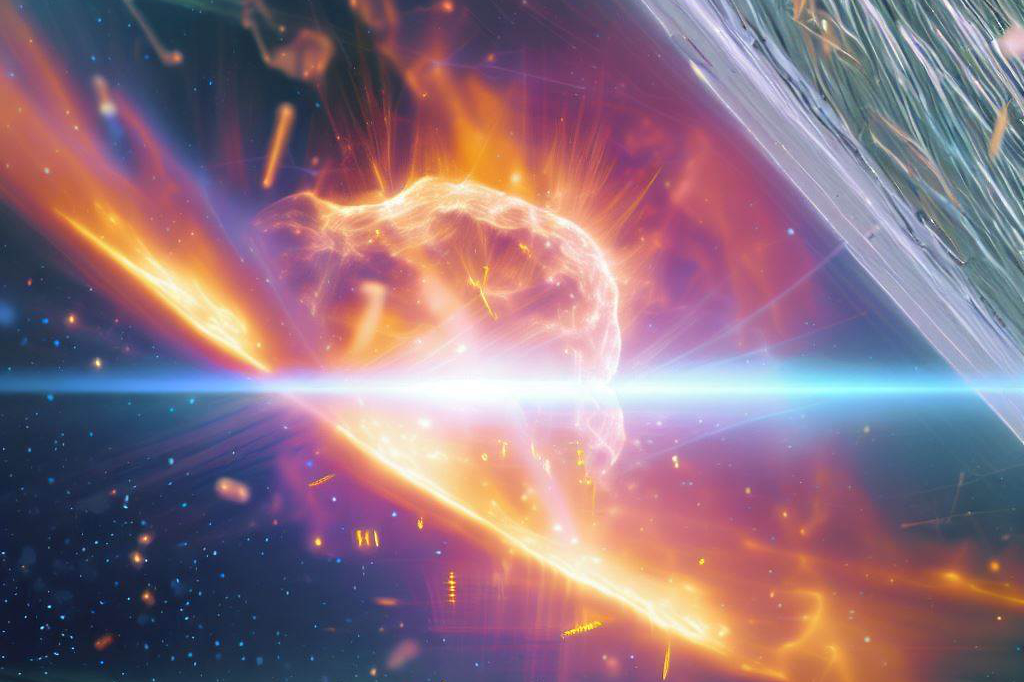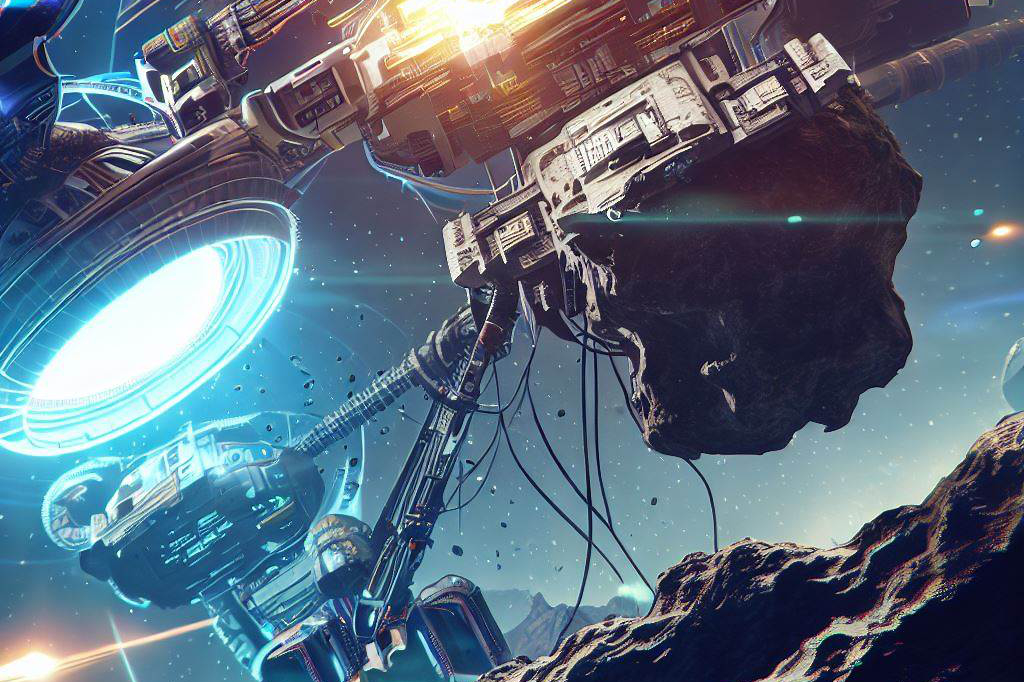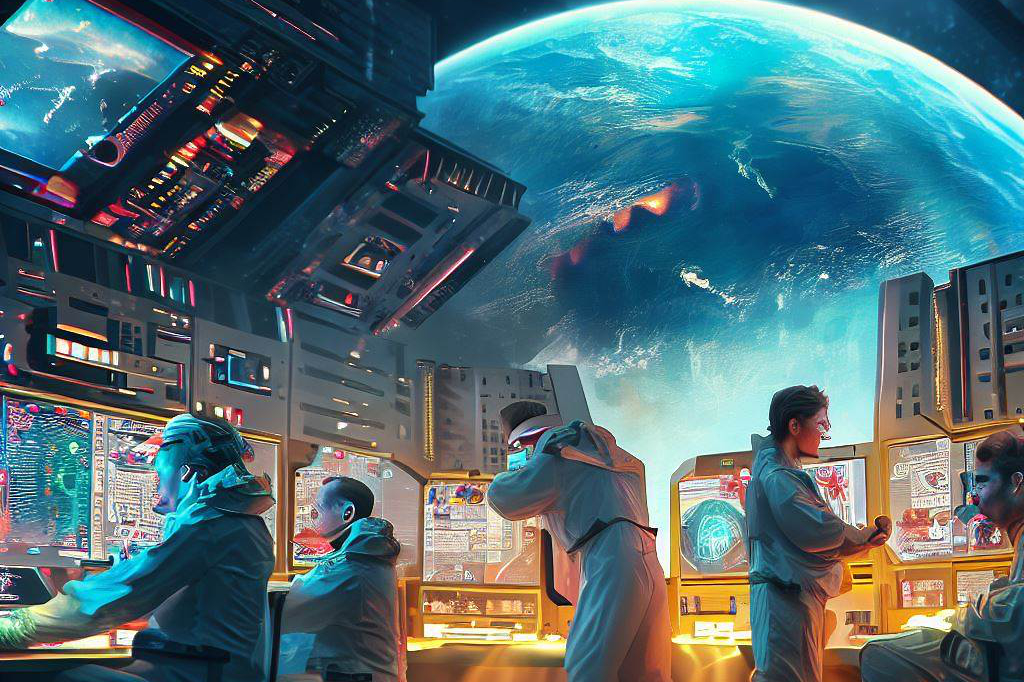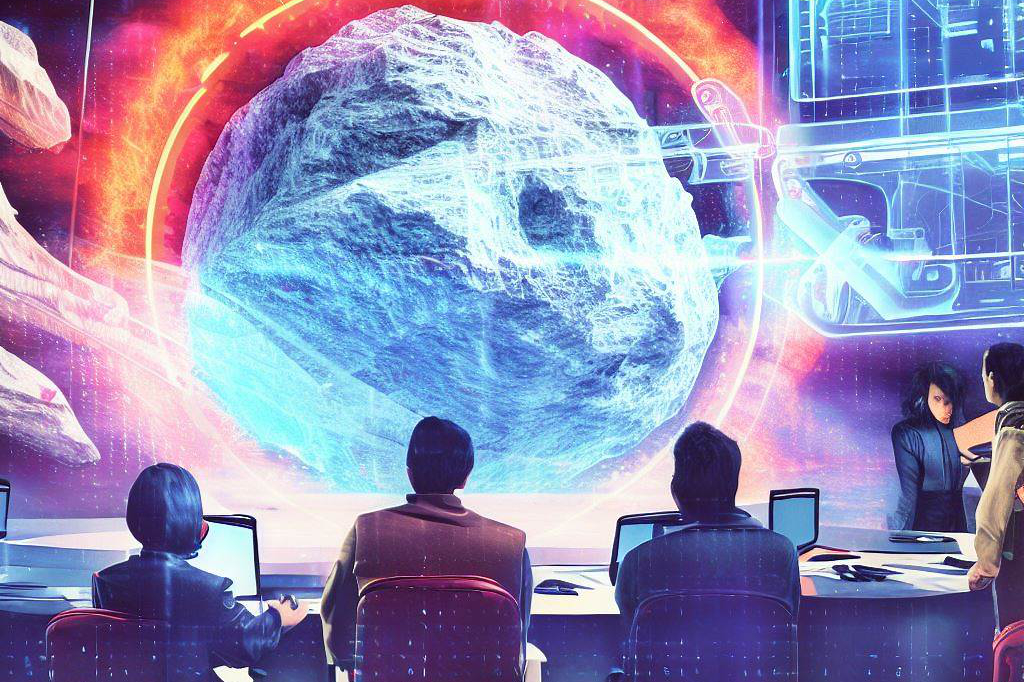As humanity continues to push the boundaries of exploration and scientific advancement, the extraction of resources from celestial bodies has emerged as a topic of great significance. The prospect of mining asteroids or extracting valuable resources from the Moon holds enormous potential for our future endeavors in space. However, with this exciting opportunity comes the need to assess its impact on both our environment and the trajectory of space exploration itself.
The Environmental Impact
The pursuit of resource extraction from celestial bodies raises critical concerns regarding its environmental impact. Celestial bodies such as asteroids and the Moon have unique ecosystems that have evolved undisturbed for billions of years.
The extraction process may disrupt their delicate balance, introducing foreign elements that could permanently alter their composition. One potential environmental consequence is the creation of artificial craters or scars on these celestial bodies’ surfaces.
The mining techniques employed, such as excavation and drilling, may leave visible marks that are expected to be long-lasting reminders of human intervention. These alterations could hinder astronomical observations and compromise future scientific investigations.
Furthermore, by extracting resources from celestial bodies, we risk depleting natural reserves that serve as reservoirs for future research and exploration opportunities. Careful consideration must be given to ensuring sustainable practices so that we do not exhaust these resources prematurely or irreversibly damage these cosmic landscapes.
The Future of Space Exploration

The extraction of resources from celestial bodies opens up new possibilities for expanding our reach into space. One immediate benefit is the availability of essential resources required for sustaining human presence beyond Earth’s confines.
Water, oxygen, and rare minerals found on asteroids or the Moon can potentially support future missions and even pave the way for establishing sustainable human settlements. By tapping into extraterrestrial sources, we become less reliant on Earth’s finite resources during long-duration missions, reducing the logistical challenges of resupplying spacecraft and minimizing the costs associated with transporting heavy payloads.
This newfound self-sufficiency can substantially enhance the efficiency and longevity of space exploration endeavors. Moreover, resource extraction from celestial bodies fuels technological innovation.
The development of advanced mining techniques, robotic systems, and extraction processes will undoubtedly lead to breakthroughs in multiple industries, with applications extending beyond space exploration. This convergence of science, engineering, and industry has the potential to revolutionize our understanding of resource utilization both on Earth and in space.
The Concept of Resource Extraction from Celestial Bodies

Underneath the vast expanse of the starry sky lies a treasure trove waiting to be tapped into – celestial bodies, such as asteroids and the moon, hold an abundance of valuable resources. Resource extraction from these extraterrestrial entities involves utilizing advanced technologies and techniques to harvest materials that can be used for various purposes.
These resources encompass a wide range, including precious metals like gold and platinum, rare minerals essential for technological advancements, water ice that can serve as fuel and life support systems in space exploration, and even potential energy sources such as helium-3 for future fusion reactors. The concept of extracting resources from celestial bodies has gained significant attention in recent years due to its potential implications for both scientific advancement and commercial ventures.
The Importance of Understanding the Impact on the Environment

As humanity ventures further into space exploration, it is crucial to comprehend the environmental impact of resource extraction from celestial bodies. While these entities may appear desolate at first glance, they possess unique ecosystems that have evolved over billions of years. Engaging in resource extraction activities without careful consideration could disrupt these delicate systems and lead to irreversible consequences.
By understanding the environmental impact, we can develop mitigation strategies that minimize damage while maximizing our utilization of extraterrestrial resources. Moreover, comprehending the impact on the environment allows us to ensure sustainable practices throughout resource extraction operations.
As responsible stewards of both Earth and outer space, it is vital to approach this endeavor with utmost caution and respect. By implementing regulations that prioritize conservation efforts and encourage ethical practices during resource extraction missions, we can strike a balance between human needs and preserving celestial bodies’ intrinsic value.
The Impact on Future Space Exploration

Resource extraction from celestial bodies holds profound implications for future space exploration endeavors. The availability of essential resources beyond Earth’s boundaries significantly reduces our reliance on Earth’s limited supplies. For instance, water ice extracted from the moon or asteroids can be converted into hydrogen and oxygen, providing a sustainable source of fuel for spacecraft and facilitating long-duration missions.
Rare minerals obtained from celestial bodies can support technological advancements, enabling the construction of more advanced space habitats and equipment. Furthermore, resource extraction from celestial bodies opens up opportunities for establishing sustainable human settlements away from Earth.
With access to vital resources, we can envision the establishment of colonies that rely on self-sufficiency rather than constant resupply missions. This not only expands our understanding of space exploration but also paves the way for future generations to thrive beyond our home planet.
Resource extraction from celestial bodies represents a paradigm shift in our understanding and utilization of extraterrestrial resources. By comprehending the concept’s intricacies, understanding its environmental impact, and recognizing its implications for future space exploration, we lay the groundwork for responsible and sustainable practices as we journey further into the cosmos.
Resource Extraction Techniques

An Overview of Different Methods used for Extracting Resources from Celestial Bodies
When it comes to resource extraction from celestial bodies such as asteroids or the Moon, various methods have been proposed and considered. These techniques aim to efficiently acquire valuable resources while minimizing their impact on the surrounding environment. In order to achieve this goal, scientists and engineers have explored several approaches that range from conventional mining techniques to advanced robotic systems.
Mining Techniques: Excavation and Drilling
One of the primary methods for resource extraction is through traditional mining techniques adapted for extraterrestrial environments. Excavation stands out as a commonly proposed method, involving the removal of surface layers or regolith using mechanical tools or explosives.
By excavating the material, valuable resources can be accessed within the celestial body. Drilling is another technique utilized in celestial body resource extraction.
This method involves penetrating deep into the surface layers to reach mineral-rich regions or potential water ice deposits. With precise drilling equipment and techniques, scientists can obtain valuable geological samples and extract necessary resources.
Both excavation and drilling present unique challenges when applied in space exploration contexts. Factors such as low-gravity environments, extreme temperatures, and limited human presence necessitate adaptations of these methods for successful resource extraction.
Utilization of Robotic Systems for Efficient Extraction
To overcome some of the challenges associated with human involvement in celestial body resource extraction, there has been a growing interest in employing robotic systems. These systems offer increased efficiency, precision, and safety during exploration missions.
Robotic explorers equipped with advanced sensors and instruments can be programmed to autonomously identify potential resource-rich areas on celestial bodies. Once identified, they can deploy specialized tools such as drills or excavators designed specifically for extraterrestrial environments.
Additionally, robots can play a crucial role by mitigating risks that may arise during resource extraction operations. They are capable of performing tasks that would otherwise be hazardous to human beings, such as operating in extreme temperatures or handling dangerous substances.
By utilizing robotic systems, the potential for successful resource extraction from celestial bodies is enhanced while reducing the potential harm to astronauts and minimizing environmental impact. Resource extraction techniques from celestial bodies involve a combination of traditional mining approaches adapted for space exploration and the utilization of advanced robotic systems.
Excavation and drilling methods allow scientists to access valuable resources buried within celestial bodies’ surfaces, while robotic systems offer increased efficiency and safety during exploration missions. By exploring and implementing these techniques, we can harness the vast resources present in space while minimizing our impact on extraterrestrial environments.
Environmental Impact Assessment

Examining the Potential Environmental Consequences of Resource Extraction
Resource extraction from celestial bodies, such as asteroids or the Moon, holds great promise for fulfilling our future space exploration and industrial needs. However, it is crucial to assess the potential environmental consequences that may arise from these activities.
While celestial bodies may appear desolate and uninhabited, they possess delicate ecosystems that must be respected and preserved. The extraction process can disrupt the natural balance and composition of these bodies in several ways.
One significant concern is the disruption caused by resource extraction to the natural balance of celestial bodies. These bodies have evolved over billions of years through complex geological processes, forming unique environments with their own set of physical and chemical properties.
By extracting resources from their surfaces or subsurface layers, we risk altering these delicate balances. For instance, removing large quantities of minerals or water could result in changes to gravitational forces or destabilization of subsurface structures, potentially leading to unintended consequences for future exploration or even scientific research.
Another potential consequence associated with resource extraction is the creation of artificial craters or scars on the surface of celestial bodies. Mining operations typically involve excavation techniques that can leave visible marks on these otherwise pristine landscapes.
These craters and scars not only mar the aesthetic beauty but also have long-lasting effects on biodiversity and geological stability. They can alter surface reflectivity, affecting temperature patterns and radiation absorption levels which could further disrupt local ecosystems.
Preserving Celestial Bodies for Future Generations
As we venture into resource extraction from celestial bodies, it becomes imperative to consider methods for mitigating environmental impact. One approach is to implement strict regulations and guidelines for sustainable practices in resource extraction operations.
This would involve careful monitoring and assessment throughout every stage of the mining process, ensuring minimal disturbance to delicate ecosystems while maximizing resource recovery efficiency. Additionally, developing technology to restore or rehabilitate affected areas is crucial to preserving the integrity of celestial bodies.
Techniques such as backfilling or reclamation can help restore the physical appearance and stability of surface areas impacted by mining operations. Furthermore, advanced robotic systems and autonomous vehicles can be employed to minimize human interference and reduce the environmental footprint of extraction activities.
By acknowledging these potential environmental consequences and implementing appropriate mitigation strategies, we can strike a balance between resource extraction and the preservation of celestial bodies. The long-term goal should be to ensure that our actions today do not compromise the integrity of these worlds for future generations.
Only through responsible resource extraction practices can we guarantee continued advancements in space exploration while safeguarding the harmony of celestial environments. (Note: As an AI language model, I cannot provide real-time information or insights on ongoing or future initiatives in resource extraction from celestial bodies. The information presented here is based on current understanding and trends in space exploration.)
Mitigation Strategies for Environmental Impact

Protecting Celestial Bodies for Future Generations
As we embark on the journey of resource extraction from celestial bodies, it is imperative that we take proactive steps to minimize the negative impact on these unique environments. One crucial aspect of this endeavor is the implementation of strict regulations and guidelines to ensure sustainable practices throughout the extraction operations.
By enforcing stringent controls, we can safeguard the integrity of celestial bodies and preserve their natural state for future generations. To achieve this, international agreements and collaborative efforts among spacefaring nations are essential.
Creating a framework that outlines clear guidelines for companies involved in resource extraction will foster responsible behavior in this nascent industry. These regulations should address issues such as waste management, limiting environmental disturbances, and ensuring compliance with ethical standards.
Technological Innovations: Restoring and Rehabilitating Affected Areas
In addition to regulatory measures, developing advanced technologies to restore or rehabilitate affected areas is crucial for mitigating environmental impact. As resource extraction techniques evolve, so too must our ability to address any potential damage caused during these operations.
Innovative solutions should focus on ways to restore ecological balance and rejuvenate celestial bodies after extraction activities have concluded. One possible approach is through bio-remediation methods tailored specifically for extraterrestrial environments.
By introducing microorganisms capable of breaking down pollutants or contaminants resulting from mining activities, we can effectively purify soil or water sources. Furthermore, research into regolith stabilization techniques can help prevent erosion and promote long-term stability on celestial body surfaces.
A Holistic Approach: Collaboration Between Scientists and Industry Experts
Achieving sustainable resource extraction necessitates collaboration between scientists well-versed in celestial body ecosystems and industry experts capable of implementing practical solutions. By bridging the gap between scientific knowledge and technological feasibility, we can develop comprehensive mitigation strategies tailored specifically to each celestial body. This collaboration should involve interdisciplinary research, including that of astrobiologists, geologists, engineers, and environmental scientists.
Through joint efforts, we can gain a better understanding of the potential risks and develop mitigation techniques that align with sustainable practices. Regular monitoring and assessment of extraction sites can help identify necessary adjustments to minimize impact and ensure long-term ecological stability.
Mitigating the environmental impact of resource extraction from celestial bodies is crucial for preserving these unique environments while advancing our understanding of space exploration. Implementing strict regulations and guidelines for sustainable practices will provide a framework for responsible behavior in this emerging industry.
Additionally, investing in technological innovations to restore affected areas promotes a proactive approach to environmental rehabilitation. By fostering collaboration between scientists and industry experts, we pave the way towards sustainable resource extraction that respects both celestial bodies and future generations.
Future Space Exploration Implications

Exploration Opportunities Enabled by Resource Extraction from Celestial Bodies
The extraction of resources from celestial bodies opens up unprecedented opportunities for future space exploration. By harnessing the abundant resources found on asteroids or the Moon, we can significantly reduce our reliance on Earth’s limited supplies while enabling deeper and more extensive exploratory missions. The availability of essential resources such as water, oxygen, and rare minerals found in these extraterrestrial bodies will prove vital for sustaining long-duration missions beyond our planet.
Availability of Essential Resources like Water, Oxygen, and Rare Minerals
One of the most exciting prospects offered by resource extraction from celestial bodies is the abundance of essential resources that can support human life and enable further exploration. Water, for instance, is a precious resource in space as it can be used for drinking, agriculture, and even converted into hydrogen fuel for propulsion.
Oxygen extracted from lunar regolith or asteroid ice can provide breathable air and serve as a propellant component. Additionally, rare minerals found in these celestial bodies hold immense scientific and economic value that can help advance technological development both on Earth and in space.
Potential for Establishing Sustainable Human Settlements Beyond Earth
The extraction of resources from celestial bodies not only facilitates short-term missions but also paves the way for establishing sustainable human settlements beyond Earth. With access to vital resources closer to potential colonization sites such as Mars or lunar bases, self-sufficiency becomes more feasible.
These extraterrestrial resources offer the opportunity to build habitats using locally sourced materials and generate energy through innovative technologies like solar power or nuclear reactors fueled by isotopes available on-site. By leveraging these available resources intelligently, we may unlock a future where humans thrive independently in off-world colonies.
Ethical Considerations

Ethical considerations are crucial when discussing the extraction of resources from celestial bodies. As we venture into space, it is essential to approach resource extraction with a strong moral compass, ensuring that our actions align with responsible practices and respect for the cosmic environment. This includes maintaining strict regulations to prevent irreversible damage to celestial bodies, implementing sustainable mining techniques that minimize pollution and waste generation, and considering the rights of potential extraterrestrial life forms that may exist.
Final Thoughts
As humanity looks beyond the confines of our home planet, the extraction of resources from celestial bodies emerges as a game-changer for space exploration. Not only does it provide us with access to critical resources necessary for sustaining long-duration missions, but it also opens up possibilities for establishing self-sustaining colonies beyond Earth’s bounds.
However, as we embark on this journey, we must remain mindful of ethical considerations and ensure responsible resource extraction practices. With careful planning and innovation, we have the potential to shape a future where humanity thrives among the stars while preserving the delicate balance of our universe.

C M, a seasoned editor, journalist, and consultant, is deeply fascinated by the convergence of technology, space, and the future of humanity.
With a particular interest in transhumanity, futurology, and the philosophical and ethical dimensions of these domains, C M serves as the lead contributor to SpaceSpotlight and TranscendSphere.
When not penning insightful articles on these rapidly evolving fields, C M indulges in their love for podcasts and books, proudly embracing their status as a ‘Happy Nerd Extraordinaire!’



